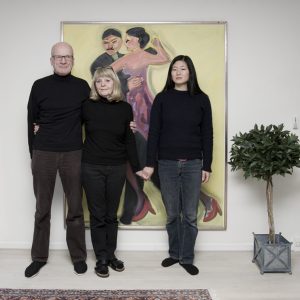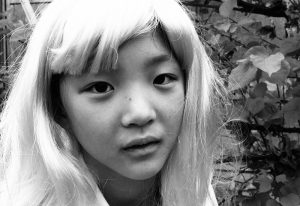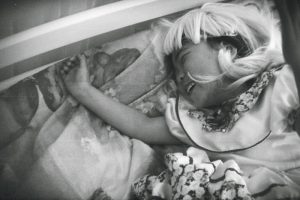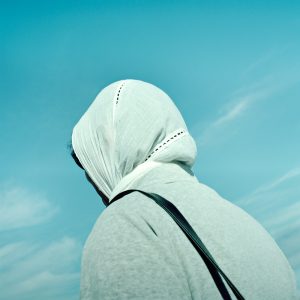She is angry about not being considered an immigrant in Denmark.
She is angry about being considered an immigrant in Denmark.
(Maja Lee Langvad: HUN ER VRED (2014; SHE IS ANGRY))
Following the 1973 oil crisis, Scandinavian governments set restrictions for work immigration from countries outside the Nordic countries. For the following 30 years, family reunification and escape from war and persecution were therefore the primary causes of immigration. During the 1970s and 1980s, the number of transnational adoptions increased. Generally, people adopted from countries outside the Nordic region are seen as beneficial to the Scandinavian welfare states where they help to satisfy the nuclear-family dream and are models of good, well-assimilated ‘immigrants’. Not everyone, however, agrees on the desirability of immigration on the grounds of refugee status, family reunification, or the new wave of work immigration that followed in the wake of EU eastward expansion. Whether you have been adopted from Korea, are an immigrant from, for example, Turkey, Iran, the former Yugoslavia, Afghanistan, Sri Lanka, or Palestine, or you were born to parents who grew up in countries outside Scandinavia or whose grandparents came to Denmark as work immigrants in the 1960s, you are – by virtue of your skin colour, your language, or your cultural background – extra visible in a white, homogeneous Scandinavia.
Iceland and Finland have considerably lower levels of immigration than Sweden, Norway, and Denmark. In the case of Finland, there was large-scale emigration to Sweden during the 1960s and 1970s where Finns became a sort of ‘Other’ within the Swedish community. A late literary depiction of the Finnish experience of emigration is found in, for example, Susanna Alakoski’s (b. 1962) Svinalängorna (2006; The Swine Rows), which deals with alcoholism, abuse, and poverty in a Finnish immigrant family living on a social housing estate, Svinalängorna, in Ystad during the 1960s and 1970s. The year 2014 saw the publication of the first Finnish novel written by a Somali-born author: Nura Farah’s (b. 1979) Aavikon tyttäret (2014; Daughters of the Desert). The novel is set in Somalia, and was therefore not the story of the realities and consequences of multiculturalism in Finland that many readers were hoping for. In Finnish and Icelandic literature, topics such as adoption, immigration, and racism are almost exclusively depicted from the perspective of ‘the natives’.

When the Norwegian-Pakistani teenager, Khalid Hussain (b. 1969), published his bestselling novel, Pakkis (1986; Paki), about the life of a teenager torn between Pakistani family traditions and the Norwegian welfare state, a journalist wrote in the Aftenposten newspaper: “We are, as usual, surprised that foreigners speak Norwegian – at least, when spoken perfectly.” While the issues raised in the novel appear to be of ongoing relevance to the Scandinavian media, if a similar statement were to be made now, 30 years on, it would stand out very clearly due to its naïve racism. However, our language and other cultural codes are still marked, albeit often in more covert ways, by divisions of ethnicity, class, and gender. Moreover, fictional works written by authors from non-Nordic ethnic and cultural backgrounds have been slow to develop . Sweden hailed Jonas Hassen Khemiri’s (b. 1978) Et öga rött (2003; One Eye Red) as the new voice of immigration, while in Denmark, having noted a lack of diversity in the literary landscape, a competition was launched in 2006 for ‘new voices’, looking for new literary perspectives from writers with ethnic minority backgrounds. The Danish initiative resulted in an anthology, Nye stemmer (2007; New Voices). Included here was Nassrin el Halawani’s (b. 1972) piece, Den etniske lov (The Ethnic Law), which can be read as an ironic comment on the double-edged nature of the competition – providing the opportunity to represent new literary perspectives while risking the pigeon-holing of a specific voice: “Clause 3: Once an ethnic minority, always an ethnic minority.” Many reviews of the anthology paid more attention to the concept than to the actual texts, and the issue of ‘integrating the immigrant voice’ in Scandinavian literature refers to more general, national climates of the debates concerning the politics of immigration, gender, and reproduction. It may be claimed, on the one hand, that literature should primarily speak for itself, and that an exaggerated focus on ethnic origin and cultural difference earmarks the literary perspective of the ‘immigrant author’ as being non-Scandinavian and non-white – in short: maintains the ‘us’ and ‘them’ logic. On the other hand, it may be claimed that literature helps to expand our horizons and broaches perspectives that are otherwise marginalised in our public debates. These approaches also bear witness to different views of the attitude to the body behind the text – ‘body’ in the sense of factors such as gender, skin colour, biography, and sexuality. Ignoring the ‘writer-body’ risks fixing it in a marginalised position, where it is not permitted to challenge the association between the body and presumed neutrality of the white majority. If, on the other hand, the body is constantly embedded in the reading of the text, there is a risk of overlooking aspects of the aesthetic articulation, which goes beyond the speech parameters set for corporeal experience.
Scandinavian authors writing about subjects such as adoption and immigration have a tendency to spotlight these parameters in their fictional works. There are also writers who often make literary use of their own life story thereby also challenging fiction’s attitude to biography and debate. They work within a feminist tradition of linking the personal and the political, and of criticising the predisposition to neutrality as a traditional white, male privilege. ‘Immigrant literature’ is a term rejected by many – one reason being that it only seems to come into play with reference to Arab or Muslim writers, whereas literature written by authors with roots in Western, or predominantly Christian, countries is not perceived as immigrant literature. This article examines literature that addresses aspects of what we call ‘identity politics’: racism, whiteness, gender, reproduction, and migration. Even though the authors are far from being exclusively immigrants in the sense of being born outside the Nordic countries to non-Nordic parents, they share the experience of having a double language or cultural identity that has been decisive in their activities and upbringing in the white North. At the same time, there are also so-called ‘white’ authors seeking to link a feminist critique with the issue of immigration and exclusion in Scandinavia.
Often, works based on themes such as adoption and immigration are often concerned with finding a form and a language through which to express these questions of identity: from texts written in ‘rinkebysvenska’ and ‘perkerdansk’ (sociolects in Sweden and Denmark, attributed to ethnic minorities), to readymades and questionnaires, and confrontational graphic works. These writers elucidate and disrupt our ingrained ways of speaking about immigration and adoption in literature that not only shows us the ‘Other’ side of multicultural reality, but also addresses the issue of ‘our’ side: public speech that is privileged and powerful in being able to express itself as neutral.
Adoption
The Nordic countries have the highest per-capita rate of international adoptions in the world. Until the late 1960s, adoption was primarily from other Nordic countries and the former West Germany. Adoption from these countries decreased, however, in step with economic and social developments in Western Europe. Adoption agencies then looked southward, and the 1970s and 1980s saw an increase in the number of children adopted from South Korea. In the early 1950s, adoption of children from abroad was a private undertaking. During the 1960s, a number of organisations were authorised to mediate contact between children’s homes and adopters – from the late 1960s, these organisations took over nearly the entire sector.
The children brought to the Nordic countries during the boom years of adoption from South Korea in the 1970s and 1980s are now adults and since the mid-1990s, a number of adoptees have published books about their specific experiences of double identity, the complex narrative of the wanted child, and the Asian body in the white North. These authors write alternative biographies, bringing in documentation material and other media, and investigate the veracity of the narratives they grew up with.
Documents, Fragments, and Genre Experiments
The hope of finding out more about their place of birth has led many adoptees back to South Korea. Many have discovered that information concerning the circumstances of their adoption had not been reported truthfully. While the narratives of ‘return’ are driven by the question of identity, the literary form employed by adoptee writers is not usually that of the traditional coming-of-age story. The publications are more fragmentary, bordering on documentation, the life story as literary genre is put to the test. In this way, it is both about acquiring more knowledge and, in a feminist tradition, shattering existing truths.
Swedish Astrid Trotzig’s (b. 1970) Blod är tjockare än vatten (1996; Blood is Thicker than Water) is an early example of ‘adoption literature’ in the Nordic region. It is a documentary style text, where the author uses short fragments to tell the reader about her adoption to Sweden and about growing up driven by the questions ‘who am I?’ and ‘what am I doing here?’ Like other coming-of-age texts, the plot moves forward by the work undertaken to find one’s place in the world. Here, however, the existential struggle is intensified because these questions are also – in a quite concrete sense – about not knowing from where or from whom you come. At the same time, the existential questions are interlaced with the narrative of being a wanted child, of market forces, and the original abandonment. Like many other adoptees, Trotzig has very little documentation about her South Korean past. She includes a so-called “SOCIAL STUDY” in the book – a document in point-form listing name, estimated date of birth, and so on, and in brief paragraphs providing a very limited account of the first five months of her life. The document concludes with a recommendation:
“VII. Worker’s Comment: She is a little cute girl who can be grown healthy a proper environment is to be provided. She can be beloved by anyone. It is therefore, recommended that she will be adopted by a suitable family for her healthy growth and development. She is a lovely small and cute girl.”
This doll-like description is typical of the commercial aspect of transnational adoption since the 1960s – in many cases, the children of impoverished unmarried women become a commodity for the prosperous Scandinavian nuclear family.
Ten years later, Danish Maja Lee Langvad (b. 1980) published Find Holger Danske (2006; Find Holger the Dane), a conceptual poetry collection comprising readymades – including reproductions of adoption papers – questionnaires, and re-writings. It is also the first work of fiction to take a critical look at the language used in Denmark with reference to immigrants: ‘popular’ humour, for example, based on differences and exclusion. One page has a list of terms used ‘humorously’ at the expense of Asian people – “Chinese-cock// Chinese-piss// Chinese-snot// Chinese-beard” – followed by a reprint of explanations from the slang dictionary linking these terms with taboos concerning the body and sexuality. There is no commentary to the list. Nor does the book comment on any of the other examples of racial humour, idiomatic expressions, and the paraphrase of Janteloven (The Law of Jante – coined by Danish-Norwegian author, Aksel Sandemose, in 1933 – in short: ‘you’re no better than anyone else’), which, ad absurdum, lists all the invalid reasons for considering yourself Danish: “2. Do not think you are a Dane simply because you speak fluent Danish.” Despite traces of Langvad’s actual biographical life, the book refrains from claiming a personal-victim vantage point with which the reader can identify. If anything, the book insists on directing attention to our ingrained language and the habit of culturally favouring the majority vantage point.
Danish writer Eva Tind (Kristensen) (b. 1974) also deals with adoption, identity, and double culture. Her books do (2009), eva+adolf (2011) and Han (2014) consist of texts, drawings, and photographs, and the constant changes of medium, lens, and scale mime the first-person narrator’s complex relationship to nation, culture, and family. In do, she inserts herself into photographs of Danish families with adopted children, thus demonstrating the basic randomness in the composition of these families. Her works are about what it means to belong to a place – an issue connected to how you belong in the language. The word do means du (you) in Jutland dialect, and in Korean it can mean person, map, sword, province; han is a Danish pronoun (he) and also a Korean word implying grief and pent-up anger. This kind of duality takes centre-stage in the experimentations of Tind’s work.

Much ’adoption literature’ is about the attempt to piece together the personal story, not necessarily just to make it complete but also to offer alternative perceptions of identity. Norwegian Geir Follevåg’s (b. 1974) Adoptert identitet (2002; Adopted Identity) mixes intimate diary entries with a theoretical reflection on autobiography as genre and its relevance to adoptee experiences: “I have been told that I have a partial life story. I am, as mentioned, a book with pages missing.” Follevåg challenges the perception of identity underlying the idea that the past, and biological origins in particular, determines who you can become. For him, the autobiographical text has the power to break with the convention of summarising a life and instead be about where you want to go and who you can become. In this context, the adoptee’s fragmentary identity shows something about the overall nature of identity. Most other examples of adoption literature are less sure about this freedom of identity. The physical point of origin is not something you can shrug off if the colour of your skin means you encounter specific expectations of who you are and what you can say. Swedish writer Patrick Lundberg’s (b. 1983) Gul utanpå (2013; Yellow on the Outside), for example, addresses encounters with prejudice in Sweden with regard to his Asian male body, while he experiences popularity in South Korea due to his Western privileges. The inability to speak Korean and understand the cultural codes makes for specific conflicts for adoptees who return to a society where they look far more like everyone else but where they are – nevertheless – different. In Lundberg’s case, he retrieves a physical and sexual identity while his Swedish upbringing keeps him “captive in a skimmed-milk consciousness”.
The Feminist Killjoys
The concept of ‘feminist killjoy’ comes from cultural theorist Sara Ahmed. Being a killjoy is about the right to disrupt the good mood by pointing out that the safe, conventional narrative is often based on the exclusion of other experiences and narratives. The feminist is by definition one such killjoy and runs the risk of having her critical voice cancelled out as being private emotional chat or even hysteria. This is also relevant in the context of adoption where the narrative of transnational adoption in the Scandinavian welfare societies has been rendered a ‘happy story’ since the 1970s – something, which may possibly have hindered parents and children alike in reflecting on the specific experiences facing the adoptee. This is the good narrative of those who are childless having the opportunity to give love to an orphan, who is thereby given the opportunity to live a safe and good life. It is the story of poverty in the Global South as the problem and adoption in the Global North as the solution. But it is also a narrative that has failed to consider the global structures, social problems, patriarchy, and capitalism that lead to people – unmarried women in particular – in developing countries to give up their children – most often girls – for adoption. In the Nordic countries, public debates on transnational adoption have traditionally focussed on the ‘humanitarian deed’ or been a matter of rectifying cases of corruption in the adoption system. In recent years, however, these perspectives have been challenged and expanded by the participation of adoptees in the debate and by the critical assessment of transnational adoption undertaken by researchers such as Lene Myong and Tobias Hübinette. Uncomfortable questions are asked, both in the literature and in the newspapers, of the system’s underlying structures and of the legitimacy of transnational adoption at all.

Maja Lee Langvad’s HUN ER VRED – Et vidnesbyrd om transnational adoption (2014; SHE IS ANGRY – A Testimony of Transnational Adoption) is another such killjoy. The concept of the books is simple: 237 pages, single sentences and short paragraphs all starting with the words “She is angry”. Sorrowful, aggressive, and succinct statements describe what she is angry about and with whom she is angry. Political, cultural, and legal circumstances, the personal narrative, and the retold experiences of others appear side by side. A factual approach (statistics, reviews, and an extensive system of notes) is mixed with self-critique, shame, and existential contemplation. The body is a plane of reaction for all of it: as a child in Denmark, she was given dairy products but she is – possibly due to her Asian body – lactose intolerant. In Seoul, she gets blisters on her hands from stress caused by these very identity issues. Taken together, the bursts of anger make for a confusion of emphatic reiterations, small shifts, and contradictions, so that the separate straightforward statements also paint a sorrowful and furious, fervently and fact-saturated dry picture of a complex anger discharged in every possible direction – inwards, too. The sense of powerlessness is real and corporeal and mixed with a helping of humour:
She is angry that it’s night.
She is angry that it’s day.
She is angry that it’s day in Copenhagen.
She is angry that it’s night in Seoul.
This is not the universal voice of reason coming into play, but a lyrical, critical, and desperately debating discourse full of hard-hitting facts and, at the same time, conscious of its own position. Langvad insists on the unavoidable relevance of the embodied perspective. The knowledge she possesses is also an embodied experience, and in contrast to the voice maintaining a neutral base for making her points, she does not attempt to hide that her perspective is a personal perspective bound up with other perspectives in the wider political context.
Family Dramas
Iranian-born Athena Farrokhzad’s (b. 1983) award-winning volume of poetry, Vitsvit (2013; White Blight, 2015), is conscious of form, uncompromising, and impassioned. It is a portrait of a family’s escape from Iran to Sweden. The book’s graphic design is striking: the silver cover works as a kind of blurred or useless mirror. Inside, the words are printed in white against a background of black bands. It looks as if someone has tried to censor the text, or it might be an inversion of the saying, that something is here ‘in black and white’ – perhaps the intention is not to present an overall absolute, or is it perhaps because the Swedish language is white? In the first section, the mother stands accused of wanting to hopelessly assimilate herself into this ‘white language’:
Min familj anlände hit i en marxistisk idétradition
Min mor fyllde genast huset med prydnadstomtar
Vägde plastgranens för- och nackdelar mot varandra
som om problemet vore hennes
På dagarna skiljde hon mellan långa och korta vokaler
som om ljuden som kom ur hennes mun
kunde tvätta olivoljan ur huden
Min mor lät blekmedlet rinna genom syntaxen
På andra sidan skiljetecknet blev hennes stavelser vitare
än en norrländsk vinter
My Family arrived here in a Marxist tradition/ My Mother immediately filled the house with Christmas knick-knacks/ Weighed the pros and cons of the plastic Christmas tree/ As if it was her problem.
During the day she distinguished between long and short vowels/ as if the sounds that came out of her mouth/ could neutralize the olive oil in her skin
My mother let bleach run through her syntax/ On the other side of punctuation her language became whiter/ than a winter in Norrland

With the exception of this first section, the text is made up of comments from mother, father, brother, grandmother, and uncle, following the form “My mother said…”, “My father said…” and so forth. We only learn about the poet through their voices. The statements are a mixture of colloquialisms, aphorisms, literary quotations, and everyday language, often in rhythmic repetitive structures. The individual statements are of an abstract nature, and the individual voices sometimes question their own fictionality: “My father said: Whose father are you rendering”. It is not an autobiographical family history we see unfold, but a more generalised and multi-voiced family drama about racism, war, seeking refuge, and assimilation, the father cast in the role of revolutionary, and the mother as pragmatist wanting to fit in.
The ‘enemy’ thus also comes from within: from the mother, whose milk, which has nourished the first-person poet-narrator, becomes barbaric milk as it becomes linked to her strategies of adapting to the ‘white’ majority, strategies the mother has tried to pass on. In the face of this, the narrator is a furious idealist. The first section ends in a robust, sorrowful, and uncompromising tone, which is characteristic of the whole book:
Tänk att jag sög på de brösten
Tänk att hon stoppade sitt barbari i min mun
To think that I sucked at those breasts/ To think that she put her barbarism in my mouth
The book presents an issue of representation that recalls Gayatri Spivak’s thesis in her essay “Can the Subaltern Speak?” (1988): that the colonised subject has no public voice – having only the colonial discourses at her disposal, she thus has to change her own perspective in order to be heard. Similarly, the immigrant writing in Swedish cannot separate herself from the dominant culture she is challenging. How, whence, and to whom can you write about the condition of exile, and about racism and assimilation in Swedish society? The brother sums up the paradox, which, like the white milk, permeates the whole work:
Min bror sa: Det enda språk du kan fördöma förgripelsen på är förgriparens språk
och förgriparens språk är ett språk som uppfanns för att rättfärdiga förgripelsen
My brother said: The only language you have to condemn the crime/ is the language of the criminal/ and the language of the criminal/ is a language invented to justify the crime
Where Farrokhzad’s volume of poetry depicts a generalised story of becoming refugees, Danish Yahya Hassan’s (b. 1995) volume, YAHYA HASSAN (2013), is an autobiographical showdown with his parents and their generation, describing a violent, hypocritical, and patriarchal culture in the deprived, Muslim immigrant environment of his upbringing. In the book, his father and uncles are portrayed as physically abusive and hypocritical, exploiting the welfare society, and not contributing anything other than a future of violence and crime for their children. While the texts are radically blasphemous, they target the father’s and others’ management of religion rather than the religion itself: “A STONE-AGE HAND A PAPERBACK-KORAN”. Furious texts written in capital letters, accusations of acting on a base of violence against fathers, the police, and social workers. Hassan describes his own violence, his time spent at various institutions, and his route towards being a “SUCCESS STORY!” about a criminal immigrant author now published by the bastion of Danish literature: the Gyldendal publishing house. In the final LONG POEM, Hassan mimes a form of ‘perkerdansk’ (sociolect attributed to ethnic minorities in Denmark), and by so doing he confronts and exposes our expectations of this kind of book. YAHYA HASSAN has sold more copies than any other debut volume of poetry in Danish publishing history, and while its eponymous author is invited to comment publicly on the Israel-Palestine conflict and Danish immigrant integration policy, he is also the subject of death threats from Muslims who are offended by his criticism of Islam. He has long been under constant police protection.
The ‘Whiteness’-Debate
Farrokhzad reviewed Hassan’s volume of poetry for the Swedish newspaper, Aftonbladet. She commented that, unlike Hassan, she could not write about her personal experiences of patriarchal abuse within the family setting, because she did not want to substantiate the racist culture of a Swedish public who equates this abuse with Middle Eastern culture. This comment provoked a reaction from the Danish critic Lars Bukdahl, writing on his blog: “You have to have a very Swedish mindset to censor yourself so emphatically and intensely.” Hassan’s volume of poetry, Farrokhzad’s review, and Bukdahl’s reaction caused an avalanche of debates about self-censorship, freedom of speech, institutionalised racism, identity, critique, and structures of power in the literary world. It was a polarised debate. One side insisted on the ‘colour-blind’ perspective and sticking rigidly to issues of form, irrespective of the author’s intention or biography, when interacting with the books while the other side suggested that the idea of being able to separate aesthetics from ethics is outdated and, at worst, helps to maintain the marginalised positions of certain literary perspectives. Similar debates in the early 2010s – concerning the racist paintings of Swedish street artist, Dan Park, and about censorship of classic children’s books with racist content – also helped generate debate about issues of racism, whiteness, privilege, and artistic freedom in the arts.

So-called ‘white’ authors also deal with issues of whiteness, gender, and racism. Julie Sten-Knudsen’s (b. 1984) Atlanterhavet vokser (2013; The Atlantic Grows), Mette Moestrup’s (b. 1969) Dø, løgn, dø (2012; Die, Lie, Die), Christina Hagen’s (b. 1980) White Girl (2012), and Hanna Hallgren’s (b.1972) Roslära (2012; On Roses) are all books, which investigate language and history while also addressing the question of what a white privileged woman can make common cause with, and the shortcomings involved when speaking, for example, from a middle-class perspective, on behalf of women, who have completely different economic and cultural backgrounds. Seen from this perspective, social critique must also involve self-critique.
While we often, more or less constructively, engage in debates about overt discrimination, problems of integration, and racism in the Nordic countries, literary works help to point out and address issues concerning the premises and inner logic of these debates and, not least, the consequences for those most affected.
Fiction
- Susanna Alakoski: Svinalängorna. Albert Bonniers Förlag, 2006.
- Nura Farah: Aavikon tyttäret. Otava, 2014
- Athena Farrokhzad: Vitsvit, Albert Bonniers Förlag, 2013. White Blight, Argos, 2015
- Geir Follevåg: Adoptert identitet. Spartacus Forlag, 2002
- Christina Hagen: White Girl. Gyldendal, 2012
- Hanna Hallgren: Roslära (Rosenlære). Pequod, 2007
- Yahya Hassan: YAHYA HASSAN. Gyldendal, 2013
- Khalid Hussain: Pakkis. Tiden Norsk Forlag, 1986.
- Jonas Hassen Khemiri: Ett öga rött. Nordstedts, 2003.
- Maja Lee Langvad: Find Holger Danske. Borgen, 2006
- Maja Lee Langvad: Hun er vred. Gladiator, 2014
- Patrick Lundberg: Gul utanpå. Rabén & Sjögren, 2013.
- Mette Moestrup: Dø løgn dø. Gyldendal, 2012
- Julie Sten-Knudsen: Atlanterhavet vokser. Gyldendal, 2013
- Eva Tind: do. Gyldendal, 2010
- Eva Tind: eva + adolf. Gyldendal, 2011
- Eva Tind: Han. Gyldendal, 2014
- Astrid Trotzig: Blod är tjockare än vatten. Albert Bonniers Förlag, 1996
Non-fiction
- Sara Ahmed: “Feminist Killjoys (And Other Willful Subjects)”. The Scholar & Feminist Online 8.3, 2010
- Tobias Hübinette: “Comforting an Orphaned Nation. Representations of International Adoption and Adopted Koreans in Korean Popular Culture”. Korean Studies Series 32, 2006
- Tobias Hübinette: “From Orphan Trains to Babylifts: Colonial Trafficking, Empire Building and Social Engineering”. Outsiders Within: Writing on Transracial Adoption, Jane Jeong Trenka, Chinyere Oparah & Sun Yung Shin (red.). South End Press, 2006
- Lene Myong: Adopteret – Fortællinger om transnational og racialiseret tilblivelse. Ph.d.-afhandling. Danmarks Pædagogiske Universitetsskole, Aarhus Universitet, 2009
- Nye stemmer, antologi. Gyldendal, 2007
- Silje Vatne Pettersen og Lars Østby: ”Innvandrere i Norge, Sverige og Danmark”. Samfunnsspeilet 5, 2013
- Gayatri Spivak: “Can the Subaltern Speak?”. Marxism and the Interpretation of Culture, Cary Nelson og Lawrence Grossberg (red.). Macmillian, 1988


